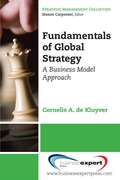- Table View
- List View
Fundamentals of Global Strategy
by Cornelis A. de KluyverThis book looks at the opportunities and risks associated with staking out a global competitive presence and introduces the fundamentals of global strategic thinking. We define crafting a global strategy in terms of change: how a company should change and adapt its core (domestic) business model to achieve a competitive advantage as it expands globally. The conceptual framework behind this definition has three fundamental building blocks: a company's core business model, the various strategic decisions a company needs to make as it globalizes its operations, and a range of globalization strategies for creating a global competitive advantage. A business model is defined in terms of four principal components: (a) market participation--who its customers are, how it reaches them and relates to them; (b) the value proposition--what a company offers its customers; (c) the supply chain infrastructure--with what resources, activities and partners it creates its offerings; and finally, (d) its management model--how it organizes and coordinates its operations. Globalization requires a company to make strategic decisions about each component of the business model. Market participation decisions include choosing which specific markets or segments to serve, domestically or abroad; what methods of distribution to use to reach target customers; and how to promote and advertise the value proposition. Globalization decisions about the value proposition touch the full range of tangible and intangible benefits a company provides to its customers (stakeholders). Decisions about a company's value chain infrastructure deal with such questions as, What key internal resources and capabilities has the company created to support the chosen value proposition and target markets? What partner network has it assembled to support the business model? How are these activities organized into an overall, coherent value creation and delivery model? Finally, strategic decisions about the global management dimension are concerned with a company's choices about a suitable global organizational structure and decision-making process. We use Pankaj Ghemawat's well-known "AAA Triangle" framework to define three generic approaches to global value creation. Adaptation strategies seek to increase revenues and market share by tailoring one or more components of a company's business model to suit local requirements or preferences. Aggregation strategies focus on achieving economies of scale or scope by creating regional or global efficiencies; they typically involve standardizing a significant portion of the value proposition and grouping together development and production processes. Arbitrage is about exploiting economic or other differences between national or regional markets, usually by locating separate parts of the supply chain in different places.
Fundamentals of Mathematics
by Denny Burzynski Wade EllisFundamentals of Mathematics is a work text that covers the traditional topics studied in a modern prealgebra course, as well as topics of estimation, elementary analytic geometry, and introductory algebra. It is intended for students who have had a previous course in prealgebra, wish to meet the prerequisite of a higher level course such as elementary algebra, and need to review fundamental mathematical concepts and techniques.
Ganit Ka Jaadu III Class 3 - Ncert
by NcertThis is a Mathematics Textbook Hindi Medium for class 3 Published by Ncert.
Ganit Ka Jaadu IV Class 4 - Ncert
by NcertThis book prescribed by central board of secondary education, India for the students of class 4th subject Ganit. This accessible version of the book doesn't leave any part of the book. The book is handy companion of the school going students. This is a Mathematics Textbook Hindi Medium for class 4 Published by Ncert.
Ganit ka Jaadu V Class 5 - Ncert
by NcertThis is a Mathematics Hindi Medium Textbook for Class 5 Published by Ncert.
General Chemistry
by Bruce Averill Patricia EldredgeThe overall goal of the authors with General Chemistry: Principles, Patterns, and Applications was to produce a text that introduces the students to the relevance and excitement of chemistry. Although much of first-year chemistry is taught as a service course, Bruce and Patricia feel there is no reason that the intrinsic excitement and potential of chemistry cannot be the focal point of the text and the course. So, they emphasize the positive aspects of chemistry and its relationship to students’ lives, which requires bringing in applications early and often. In addition, the authors feel that many first year chemistry students have an enthusiasm for biologically and medically relevant topics, so they use an integrated approach in their text that includes explicit discussions of biological and environmental applications of chemistry. Topics relevant to materials science are also introduced to meet the more specific needs of engineering students.
General Chemistry
by Bruce Averill Patricia EldredgeThe overall goal of the authors with General Chemistry: Principles, Patterns, and Applications was to produce a text that introduces the students to the relevance and excitement of chemistry. Although much of first-year chemistry is taught as a service course, Bruce and Patricia feel there is no reason that the intrinsic excitement and potential of chemistry cannot be the focal point of the text and the course. So, they emphasize the positive aspects of chemistry and its relationship to students' lives, which requires bringing in applications early and often. In addition, the authors feel that many first year chemistry students have an enthusiasm for biologically and medically relevant topics, so they use an integrated approach in their text that includes explicit discussions of biological and environmental applications of chemistry. Topics relevant to materials science are also introduced to meet the more specific needs of engineering students.
General Studies Indian Economy I and II - competitive exam
by Sriram IasThe best book on Indian Economy By SRIRAM IAS, recommended by civil service exam experts. The book includes the previous year question and point by point description and analysis.
Government Regulation and the Legal Environment of Business
by Don Mayer Daniel M. Warner George J. Siedel Jethro K. LiebermanMayer, Warner, Siedel and Lieberman's Government Regulation and the Legal Environment of Business is an up-to-date textbook that covers legal issues that students must understand in today’s highly regulated business environment. The text is organized to permit instructors to tailor the materials to their particular approach. The authors take special care to engage students by relating law to everyday events with their clear, concise and readable style.
Growth and Competitive Strategy in 3 Circles
by Joel E. Urbany James H. DavisGrowth and competitive advantage are about effective positioning. Building effective positioning is challenging today for firms facing new and stronger competition, volatile and uncertain markets, and shifting customer desires and demands. The 3-Circle model facilitates speed of understanding and action by focusing attention on the most critical strategy concepts in this uncertain environment. Growth strategy emerges in the model from systematically addressing four key strategy directives in a deep and disciplined way: 1. define, build, and defend the unique value you create for customers; 2. correct, eliminate, or reveal value that is failing customers, which they're not aware of; 3. potentially neutralize the unique value created for customers by competitors; 4. explore and exploit new growth opportunities through deep understanding of customers' unmet needs.
Happy Maths 2: Shapes and Data
by Mala Kumar Angie UpeshSankhya and Ganith learn that different shapes have different properties.
Happy Maths 3: Measurements
by Mala Kumar Angie UpeshSankhya and Ganith have fun measuring a lot of things.
Happy Maths 4: Time and Money
by Mala Kumar Angie UpeshSankhya and Ganith spend some time learning about money.


